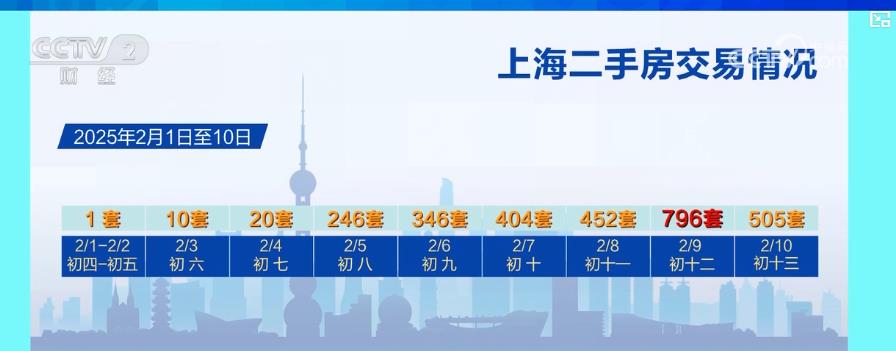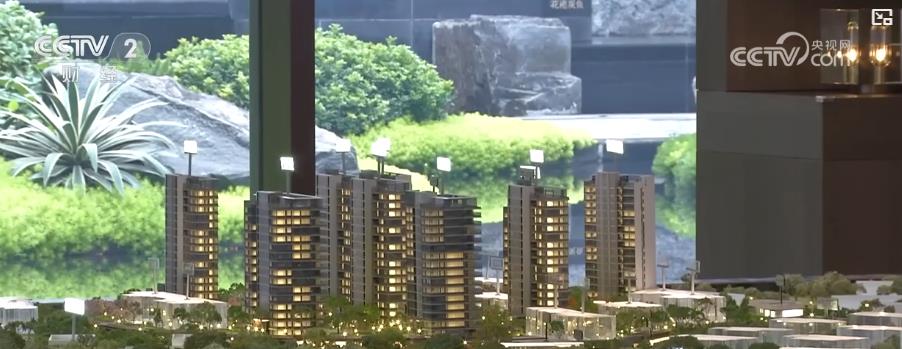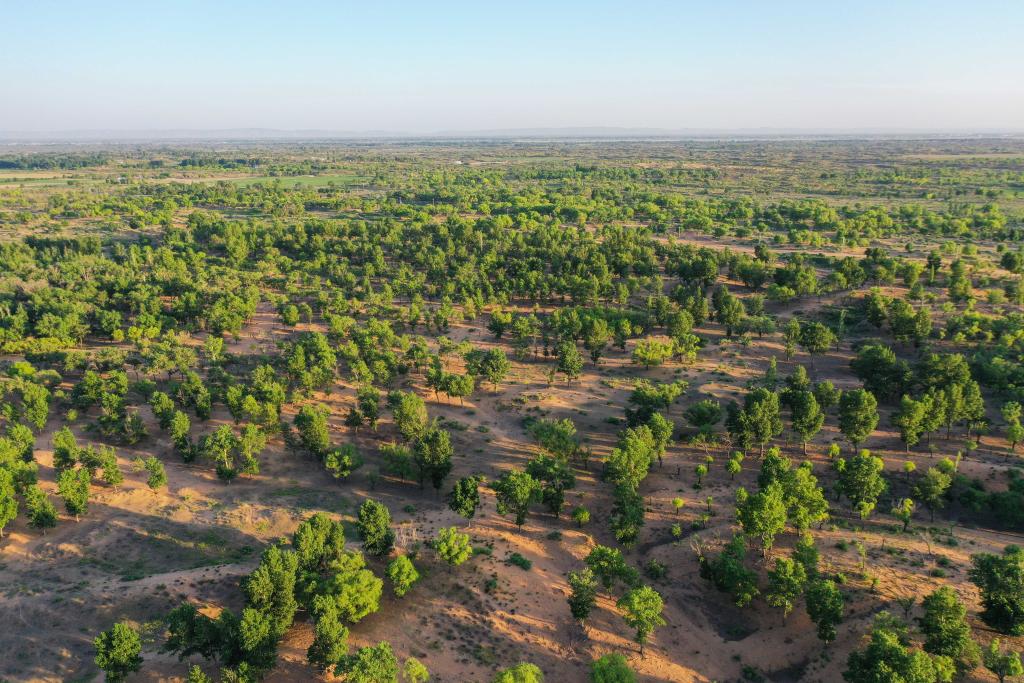
This is a forest taken in Mu Us Sandy Land on June 14, 2023 (drone photo). Photo by Xinhua News Agency reporter Liu Lei
In the late winter, the edge of the Kubuqi Desert on the south bank of the Yellow River is busy. Desert prevention and control workers seized the opportunity to check for leaks and fill gaps in the desert, patching up grass squares. After 50-year-old farmer Zhang Yong cleaned up the wheat straw, he neatly stacked it on the edge of the square drawn in advance on the sand, and then used a shovel to press hard along the edge. The whole process was completed in one go.
Looking at the uniform grass squares, Zhang Yong smiled: "Grass squares are a sand control method that prevents wind, fixes sand, and conserves water. The grass squares are repaired every winter, and they wait until spring. It can firmly lock the yellow sand."
The Kubuqi Desert is the seventh largest desert in China, with a total area of 14,100 square kilometers. It stretches across northern China like a giant dragon.
Wurigen, who lives deep in the Kubuqi Desert, has only one color in his childhood memories. "There is endless yellow sand on the stove and cabinet at home, and there is Shaliang when I go out." Wu Ri even recalled that there was a folk song in his hometown that said, "People in the sand are miserable, people in the sand are tired, the sky is full of wind and sand, and there is no vegetation..."< /p>
In order to effectively control the Kubuqi Desert, in the 1950s and 1960s, with strong support from the state, Inner Mongolia built three state-run desertification control stations and began afforestation and desertification control on the northern edge of the Kubuqi Desert. Since then, Wu Rigeng’s hometown has gradually become greener and more vibrant.
“At that time, people regarded managing the Kubuqi Desert as a mission. After the older generation finished the work, the next generation took over. There were more and more trees in the desert, and ecological deterioration was effectively curbed.” Wu Wu Ri Geng said.
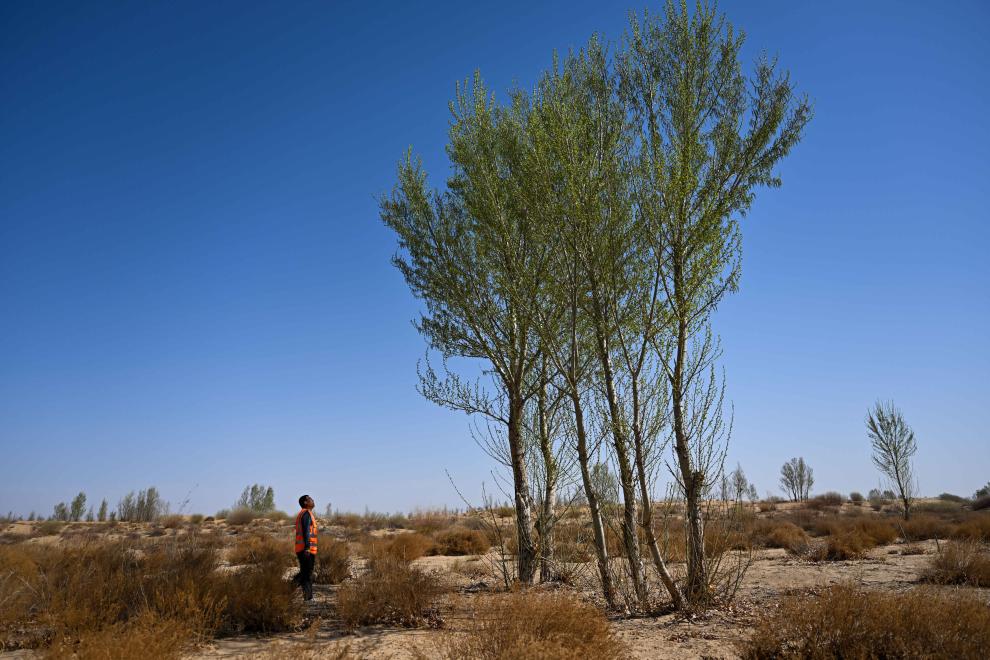 < /p>
< /p>
On April 11, 2024, a sand controller patrolled trees in the Kubuqi Desert in Dalat Banner. Xinhua News Agency reporter Li Zhipeng Photo
As one of the provinces and regions in China where desertification and desertification land are most concentrated and harmful, Inner Mongolia has made desertification prevention and control the main task of desertification prevention and control for many years, and continues to fight against the "Three North" project , vigorously promote the natural forest protection project and the Beijing-Tianjin sandstorm source control project, continue to return farmland to forest, return grazing to grassland, implement the grass-livestock balance and grazing ban and rest grazing system, and continuously implement grassland ecological rewards and subsidies to allow the grassland to recuperate.
The reporter learned from the third session of the 14th National People's Congress of the Inner Mongolia Autonomous Region that opened on January 14 that in 2024, Inner Mongolia's desertification control, afforestation, and grass planting completed 113%, 220%, and 148% of the annual targets respectively. %.
At present, Inner Mongolia’s forest area reaches 357 million acres, ranking first in the country; the comprehensive grassland vegetation coverage reaches 45%, reaching the best level since 1990.
Recently, the Hunshandake Sand Land in Sunit Right Banner of Xilingol League has been freezing cold and covered with snow. On the more than 10,000 acres of pasture owned by herdsman Wangjila, shrubs such as Haloxylon ammodendron, Caragana, and Elaeagnus are grown one after another. Occasionally there is a string of small, slender and horn-shaped footprints on the ground, which Wangjila said were left by roe deer.
The pasture of Wangjila’s family is located in the hinterland of Hunshandake Sandy Land. In the past, the grassland was sparse and the wind and sand were rampant. In order to make the grassland green again, he started planting grass and trees in the deserted areas of the grassland in 1998. After repeated planting trials, Wangira has mastered the distribution of semi-mobile sand dunes and fixed sand dunes and the plants suitable for planting. After that, he built sand barriers on the moving sand dunes and planted yew, caragana and other plants on the fixed sand dunes, and achieved good results.
Wanjila said with emotion that preventing and controlling desertification requires constant exploration and silent persistence over many years before we can see results. Today, Wangjila has planted more than 2,300 acres of sand dunes and sand nests with green, and planted more than ten kinds of drought-resistant saplings such as Haloxylon ammodendron, Caragana, and Elaeagnus, totaling more than 22,000 trees.
The Hunshandake Sandy Land in Xilingol League covers an area of 52.942 million acres, accounting for more than 80% of the total sandy area. Since 2023, the local area has relied on the "Three North" project to insist on natural restoration and engineering management Combined, the desert control area will reach 3.78 million acres in 2024, achieving a historic transformation from "sands advance and people retreat" to "greens advance and sand recedes".
Lu Qi, chief scientist of the Chinese Academy of Forestry and president of the Three-North Engineering Research Institute, said that in the practice of preventing and controlling desertification, China has embarked on a governance path of "green, prosperous and co-prosperous" to promote global Desertification prevention and control contributes Chinese wisdom.
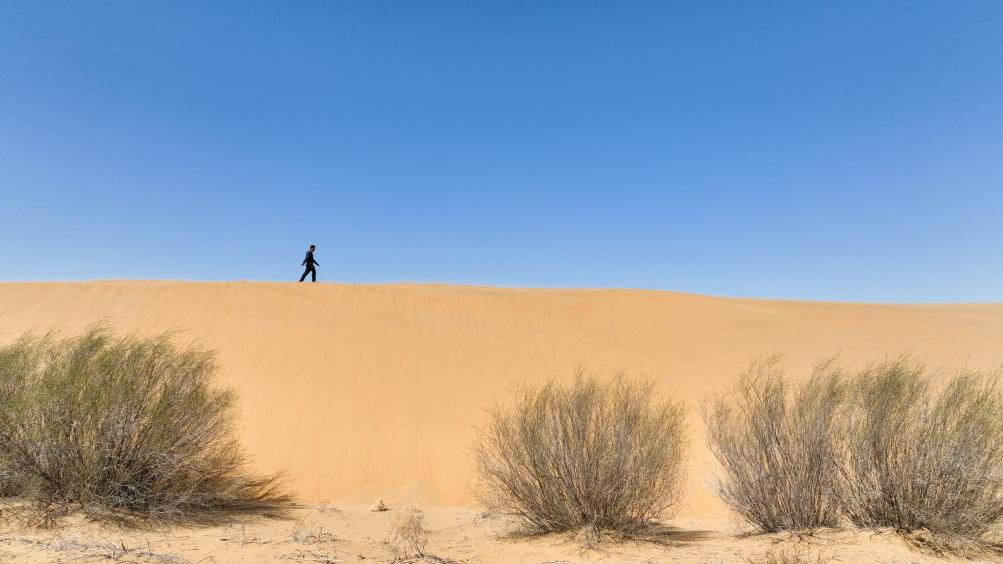 < /p>
< /p>
On April 11, 2024, a desert control worker walked in the Kubuqi Desert in Dalat Banner (drone photo). Photo by Xinhua News Agency reporter Behe
Walking into the Alxa League Suhaitu Gacha, there is a gully more than half a meter deep in the forest of Haloxylon ammodendron as tall as a person. Herder Naren carefully took out a Cistanche deserticola with slender roots.
In recent years, grazing has been banned in the area, and Naren has been actively engaged in the sand industry under the guidance of the government. "My 5,000 acres of Haloxylon ammodendron forest can not only fix sand, but also increase income by an average of 150,000 yuan per year after grafting Cistanche deserticola," she said.
Inner Mongolia closely integrates desertification prevention and control with industrial development and improvement of people's livelihood, and vigorously develops advantageous industries such as sandy forest fruits, Chinese herbal medicines, photovoltaic new energy, and desert tourism to improve the comprehensive benefits of desertification control. At present, Alxa League has built three million-acre industrial bases of Haloxylon ammodendron - Cistanche deserticola, White Thorn - Cynomorium cynomorium, and flower stick seed collection. In 2023, the output value of the forest and sand industry will reach 10 billion yuan.
Today, Inner Mongolia’s desert control methods, technologies and results have been successfully replicated in Xinjiang, Tibet, Qinghai, Gansu and other places, and promoted to Saudi Arabia, Mongolia and other countries co-building the “Belt and Road”. In 2024, while helping Mongolia carry out desertification prevention and control skills training, Inner Mongolia will export 2.826 million seedlings to the country to support its effective desertification prevention and control. (Reporters Halina, Yu Jia)


